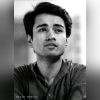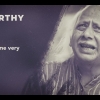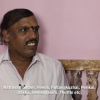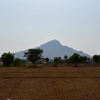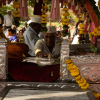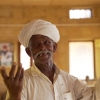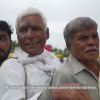Kumkum Mohanty was one for the early disciples of Guru Kelucharan Mohapatra. In the years that followed the Jayantika movement, Mohapatra created many of his signature compositions for Mohanty and Sanjukta Panigrahi. Kumkum Mohanty joined Indian Postal Service in 1970 and left the field of dance. In 1983, she came to Odisha on deputation upon the invitation of J.B. Pattnaik, and she established Odissi Research Centre. While at the helm of Odissi Research Centre, Mohanty collaborated with Guru Kelucharan Mohapatra, Sanjukta Panigrahi, and several music and Sanskrit scholars in preparing a terminology for the basic stances, movements and mudras of Odissi and visually recording each of them. Based on their efforts, Mohanty brought out a manual for Odissi: The Odissi Dance Path Finder. Through her initiative, performances of legendary gurus such as Pankaj Charan das, Debaprasad Das, and Mohapatra were recorded and preserved at Odissi Research Centre. Kumkum Mohanty has performed in all major dance festivals and music conferences across India and abroad. She runs an institute for Odissi dance called Geeta Govinda in Bhubaneswar.
Following is an edited version of the conversation with Kumkum Mohanty conducted by Madhur Gupta in 2018.
Kumkum Mohanty: Once, when I returned home from school, I told my father that my friend was going for a dance programme, and that I too wanted to learn dance. He said: OK. In the meantime, Guruji (Kelucharan Mohapatra) was teaching my elder sister at my house. Another sister was learning sitar from Syamsunder Dev. He also used to come home to teach. So, that way my father was so liberal. He had so much respect for classical arts. I realise it now. Then he admitted me to Kala Vikash Kendra (institution started in 1954 in Cuttack for dance and music) for both dance and music.
Madhur Gupta: How old were you?
KM: I was in class 7, probably 11 years old or so. Kala Vikash Kendra was in a place called Ranikhat. There was this thatched temple with two rooms. Guruji was holding classes there. It was a branch of Kala Vikash Kedra. The main Kala Vikash Kendra was very far. So, I had to go to Ranikhat. They had a rickshaw that would come and fetch me. Guruji would teach me in the thatched house. Once he brought a bunch of flowers. Will you take these? he asked. You know the drill [that you do in school]? Do the drill. Whatever drill I was doing in school, I did that. That was how he started teaching me. Then within a year, that branch was closed and Kala Vikash Kendra was shifted to Banga Bazar. It was a big building. He called me there. At that time Guruji used to compose short dance dramas. He gave me the role of Radha. There were other senior dancers who knew much more than me. They were jealous. A new girl, that too a fat girl, and Guruji made her Radha! How could he do that? But I performed very well. Whatever Guruji asked me to do, I did meticulously on the stage. That was the beginning. Then there was no looking back.
MG: Was there a set Odissi repertoire at the time when you started learning the dance?
KM: It was created by then. Jayantika (association of dancers, gurus and other experts formed to decide on the structure and framework of Odissi) was already formed in ‘55. They had created a repertoire by the time I started learning in ‘57 or ‘58. Batu (a pure dance item in the repertoire), Mangalacharan (marks the dancer’s entrance on the stage) was there. We had only two pallavis (an item of pure dance known by the name of the raga its music is based on)—Kalyan Pallavi and Basant Pallavi. In retrospect, I won’t call the latter a pallavi because there was no elaboration of the raga. It was just a refrain to do some footwork. But Kalyan Pallavi was there. But, actually, it was not Kalyan Pallavi, it was Chandrakantha Pallavi. At that time, they used to call it Kalyan. But later at Odissi Research Centre I found out that it was actually Chandrakantha raga. Then Guruji taught us two–three abhinayas also.
MG: Which were they?
KM: One was Samakujuharo. There was another song. A simple one. There was no sanchari (elaboration of usually a one-line verse). At the same time, at Kala Vikash Kendra, we used to do some beautiful items like Pholobramara, Sachaswani, etc. In Sachaswani, the farmer and his family are going to the fields and harvesting with sickle and all. I still remember the music in Pholobramara. There was another item which Guruji composed for Children’s Little Theatre. It was a little train item. I was the engine. There were four passengers. The dance consisted of only footwork. The train would come and pause on the stage. Then chaiwala, and other vendors would come and sell their things.
Since the authentic Odissi repertoire was short, these items were composed to fill in the gap to justify a 2-hour full-fledged programme. He had to mix these items with the Odissi repertoire. But these items gave me a lot of experience. I still remember them. In fact, I am going to revive one of them. Then, in the meantime, we had regular dance examination too at the Kendra. I finished my Nrityabhooshan course while I was in school itself. Then my father stopped my dance classes. Once you are in college, you can’t go for dance. You cannot go out of the house. But Guruji started holding summer workshops, and I could attend them.
MG: Were those conducted in his house?
KM: No, at Kala Vikash Kendra, and only during summers. When Guruji left Kala Vikash Kendra, I also left. My father said: You can’t go anymore.
MG: But you used to attend summer workshops…?
KM: Yes. Bibhooshana Pushpa also taught there. I still remember some items that he taught. Then another organisation in Cuttack . . . Kumar Utsav Samiti—some young art lovers founded this samiti—and once in a year on Kumar Purnima Day, they would arrange a beautiful programme. It contained a chorus song, a beautiful dance item, then there was chorus, drama, etc.
MG: How did the artistes get together and learn these items?
KM: There was no question of learning together. At that time, there were two important dance schools in Cuttack. Kala Vikash Kendra and National Music Association, where Deb Babu (Deb Prasad Das) was teaching. These two institutions were competing. But for Kumar Utsav Samiti programmes both the institutions came together to perform. The best students of both institutions and all the artistes at All India Radio would come together. Nobody would ask for money. It was for a common cause. I tell you, the best possible dance dramas were composed at that time in the years ‘63, ‘64, ‘65, ‘67 and ‘68.
At Kala Vikash Kendra, Guruji composed a dance drama, Pancha Pushpa, on the story of Madan and Rati. Sanjukta was learning Bharatanatyam at Kalakshetra then. She would come during summer vacations. Sanjukta and I—we were always made a pair in the dances. Guruji would make Sanju the heroine and me the hero. She was Madan and I was Rati. And the best dancers in the class became the five flowers. I still remember that dance drama. Then, for the Kumar Utsav Samiti programme, again Sanju would come for puja vacation. Till the time I left Odissi, whatever Guruji created, he would make Sanju the heroine and me the hero. Beautiful dance dramas were composed by him. But Guruji was directed by Surenmanthi and Gobind Tej. They used to write scripts, and would sit down with Guruji for composing. They would explain everything to Guruji. Gobind Tej was a cinema director. I still remember these two were guiding Guruji in creating the dance choreography. Bhuvaneshwar Mishra was composing the music, and the instruments were played by the staff of All India Radio—violin, flute, harmonium, etc. Everyone had so much love for art at that time. None of them bothered about money. They were satisfied with tea, some snacks and, of course, paan. It was pure and simple love for dance and music. At that time, unfortunately, there was no video camera. AIR recorded and aired only the music.
So, the best dance dramas were composed by Kumar Utsav Samiti. Around the same time, P.V. Krishnamoorthi became the director of AIR. Being a very good artiste and a dynamic character, he started composing dance dramas for AIR. I still remember, I was in class 8 then. Krishna Gatha was composed then. The script was by Surenmanthi. Views of five poets—their views on Krishna, ideas of Krishna leela—that was Krishna Gatha. Then there was an audition for the role of Krishna. Guruji, Krishnamoorthi, Gobind Tej—all of them were there. Many girls went. I too went. I was selected.
There were many other compositions created by AIR artistes. One was on the river Mahanadi. When the Hirakud dam was opened, Nehru (Jawaharlal Nehru) came to inaugurate it. It was in ‘60. For the inauguration ceremony, a dance drama was composed by Guruji. A beautiful dance drama, I still remember. Then, another dance drama that AIR did was Chandrika. During the tenure of P.V. Krishnamoorthy, many dance dramas were composed. So, those dance dramas and the Kumar Utsav dance dramas—they were all big experiments for Guruji. For us too, definitely. We played different roles in different dance dramas. So, naturally your experience of expression, dance, script… everything grows.
MG: So, Guruji’s expertise was developed through these experiences.
KM: Naturally. I saw how Guruji developed. Because I am the only witness. I have seen his both sides—AIR, KVK. In ‘61, in KVK, Babulal Joshi produced a ballet. You won’t believe it. Guruji prepared two revolving stages for that. It was six stages on two levels in total. The duration of this particular dance drama was two hours. It was the best production of the time. At that time the cost came to Rs. 27,000. Now it would be 27 lakhs.
In ‘63 or ‘64, Vijayanagaram Music School invited me to dance. For the first time, I performed Odissi for an hour. The repertoire consisted of Dashavataram, Lalita Lavangalatha, Samakujuhara, batu and pallavi. All these items in one hour. Then in ‘65, Karan Singh visited Odisha. I was invited to dance at the governor’s house. At that time, Sankarabharanam Pallavi was composed for the first time. So, between Chandrakantha Pallavi and Sankarabharanam Pallavi, there was a gap of ten years. The former was done in ‘55.
MG: So, Guruji didn’t compose any pallavi in between?
KM: I won’t blame Guruji. You are a dancer. What can you do without music? Music is the soul of dance.
MG: What about Bhuvaneshwar Mishra?
KM: That collaboration came later, in my house. My parents called Bhuvaneshwar Mishra. Rakhalmanthi was also there. So, Rakhalmanthi, Bhuvaneshwar Mishra and Guruji would sit in my house from 9 at night and work on the compositions. Then the turning point in my dance career—when I was noticed at national level—came in ‘67. Sangeet Natak Akademi called a seminar on Jayadeva’s Gitagovinda. Guruji came and told my father that he wanted to take me for a performance during the seminar.
MG: What did you perform?
KM: I was doing my postgraduation then. I didn’t want to go at first. But my father insisted. He said: I know your calibre, you should not waste this opportunity, you should go. Then we started choreographing several Gitagovinda songs— Pashyati Dishi Dishi, Sakhi He, Dheera Sameere—most of these Guruji composed at that time. Once Guruji was teaching me Pashyati, my mother was sitting on a small stool, making paan for Guruji. Guruji called me and pointed at her and said: Look at the way she is sitting. Just like a sculpture. You have to emulate that poise and grace. But then my mother had a beautiful figure. Guruji was a connoisseur of beauty. He was a great observer. He immediately observed how she was sitting, her grace and poise. Guruji would teach me till 2 in the night. Bhuveshwar Mishra and Rakhalmanth also would be there. And after 2, they would leave, my mother would prepare coffee for me, and I used to study International Law till 5 in the morning. At the same time, I used to remember the dance lessons too. When the dance classes were on, my mother would keep up a steady supply of tea, snacks and paan.
MG: So, tell me, was girls learning dance acceptable in society then?
KM: It was accepted up to a particular age. After that, girls were stopped from learning dance. Once they got married or after they completed school. Even my dance classes were stopped. I was not allowed to go to Kala Vikash Kendra. But Guruji somehow caught me, and my father was liberal enough to send me, at least, to the summer classes. My father actually blackmailed me. He said: Unless you get first class, you will not be allowed to practice. So, in order to keep up the dance I had to study. Then he knew my calibre. I come from a very traditional family. My father’s elder brothers did not like dance. After graduation, daughters should be married off. But I was the youngest in my family. And all my elder uncles, they used to like me because I was doing so well in studies. But in ‘66, again there was a programme, I wanted a new item. I told Guruji I am not dancing the same thing over and over again. Teach me something else. So, he composed the Saveri Pallavi.
MG: So, first Kalyan was composed, then Sankarabharanam, and then Saveri.
KM: Aravi was done in ‘70. It went on like this till I left Odisha to go to Mussorie for my (Indian Postal Service) training. I still have that harmonium with me. I asked my father to buy a harmonium for me. He bought it for Rs. 28. That little harmonium is the mother of all the pallavis. I still preserve it. Guruji used to bring the pakhavaj. Mishraji had formal training in music. Guruji had never had any formal training. But he had unique intelligence. But I had seen at my house how Mishraji taught Guruji to make patterns of gathis (foot movement) and all that. I would be sitting on the ground, my grandmother would sleep on a cot in the room, and on another cot would be Guruji, Mishraji and Rakhalmanthi. My parents sat in chairs. For composing a minute of music, they would generally spent three hours. Guruji kept his leg over the pakhavaj and close his eyes. Both of them would be deep in thought, their eyes shut. At around 12:30, Guruji would open his eyes and say, come let us learn. You see, they worked in tandem, first the music was set, then the dance was composed. Mishraji also was intelligent to know Guruji’s thought process. After one bit was taught, they would again meditate on the next bit. I would sit and wait. But the music part took two and a half to three hours. If it was a difficult step, Guruji would make me dance throughout the night, a hundred times. Then he used to experiment, which footwork would suit which music. One thing is, since I was a student, I had to go to the college the next day. But Guruji would go back home. He would sing the first line—the sthayi—throughout the day and night. Which pakhavaj syllable would suit which music—that was his major contribution. Dance was there, of course. But his contribution in music composition was big. He used to play every instrument. He had tremendous knowledge about all the instruments. And the songs he selected for choreography were popular. To bring those songs into the classical framework—was the contribution of Guruji. I consider Bhuvaneshwar Mishra as the mother of Odissi, and Guruji as the father of Odissi.
MG: In which year did you get married?
KM: In ‘72. I used to dance and Sanju used to dance. After I joined the service, my place was left vacant. Guruji started dancing to fill the gap. He never performed before. He was always happy with the pakhavaj, accompanying the dance performance. But then, when I left, he began to perform in my place.

